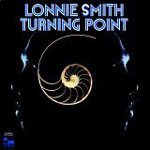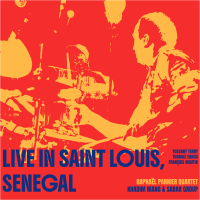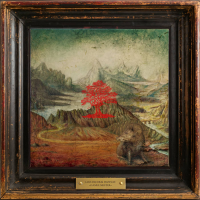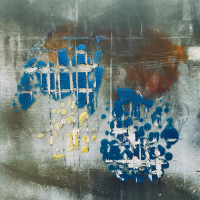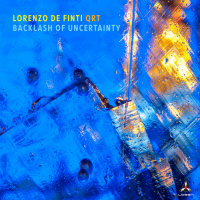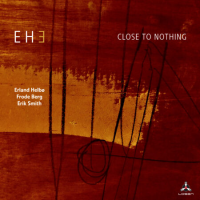Home » Jazz Articles » Extended Analysis » King Crimson: The 21st Century Guide to King Crimson Vol...
King Crimson: The 21st Century Guide to King Crimson Volume Two: 1981-2003
Merriam-Webster defines the word progressive as: "making use of or interested in new ideas, findings, or opportunities," and "moving forward or onward." Of many of the groups that were labeled with the progressive epithet, all too few of those remaining have actually really embodied the concept. While Yes continues to produce new albums—many with the "classic" line-up—in performance the lion's share of current set lists are devoted to material from its inarguably most intrepid period, from The Yes Album (Atlantic, 1971) through Going for the One (Atlantic, 1977). Others, like Gentle Giant, while gaining new fans with their recent spate of 35th Anniversary remastered reissue series, have had the good sense not to reform and attempt to recreate past glories.
Of the "major" progressive acts to emerge in the late 1960s-early 1970s, only King Crimson has embodied a philosophy that steadfastly refuses to look back. In fact, with very rare exception, no incarnation of Crimson has ever covered past material beyond one generation back. As the humorous novelty track—"The King Crimson Barbershop"—one of many tasty extras to be found on The 21st Century Guide to King Crimson Volume Two: 1981-2003 (Discipline Global Mobile, 2005), follow-up to last year's successful The 21st Century Guide to King Crimson Volume One: 1969-1974 (Discipline Global Mobile, 2004) says—"We don't do 21st Century Schizoid Man." The barbershop quartet (bassist/stick man Tony Levin, in fact, singing all parts) also encourages you to "tap your foot in twenty-one" and states "no photos please," comments that may surprise those who didn't already know that Fripp, in fact, possesses a rather wickedly dry sense of humour—although Fripp's feelings about photography during live performances are no laughing matter.
Perhaps it's because Fripp has the uncanny ability to recognize when a particular version of Crimson has either reached its zenith or, conversely, has become simply too impractical a unit—something antithetical to his vision of a "small, intelligent, mobile working unit" that he'd conceived in 1974 when he broke up the band that had recorded Larks' Tongues in Aspic (Discipline Global Mobile, 1973), Starless and Bible Black (Discipline Global Mobile, 1974), Red (Discipline Global Mobile, 1974) and USA (Discipline Global Mobile, 1975)—the longest-running Crimson at that point. Perhaps it's that he considers, amongst other things, technological trends to be inherent in creating a space where it's time for a new Crimson—much like a film director who waits to make a film until the available technology arrives to allow him to make real his vision. Regardless of motivation, one thing is certain: while it's possible to draw a distinct line from Crimson's earliest foundations to its latest, the differences far outweigh the similarities, and every new version of Crimson both responds to and drives the music of whatever time it finds itself.
The 1981-1984 version of Crimson was, in fact, going to be another group entirely, called Discipline. But when Fripp, guitarist Adrian Belew, Levin and drummer Bill Bruford—Bruford being the only carry-over from the 1974 version—got together and played, it became clear that this was, indeed, a progressive group in the spirit of the word and the spirit of King Crimson in particular. With Belew's reckless abandon being a perfect complement and counterpoint to Fripp's more inherently logical technical prowess, Crimson, for the first time, became a two-guitar band—one where the whole was far greater than the sum of its parts. And with the advent of practical, road-worthy guitar synthesizers, it was possible for these two instruments to create a more all-inclusive world of sound. Gone were the mellotrons of old, but with both Belew and Fripp using the Roland guitar synthesizer technology, it was possible to emulate those rudimentary orchestral sounds and much more.
Levin had already introduced the tapped Chapman Stick on albums by Peter Gabriel, but here it became an even more dominant voice. Bruford, like many drummers, was exploring the electronic drums of the time, but continued to find innovative ways to use them, culminating in his own Earthworks Mark I project at the end of the 1980s, where his chordal drum system was able to, at least some of the time, supplant keyboard-based synthesizer technology.
And so, there were all kinds of new technologies to differentiate King Crimson from its 1970s past. As much influenced by the concept of dance music, beat poetry and more avant-garde leanings, Crimson came off sounding nothing like an anachronism. In a world where Talking Heads was extremely popular, Belew's clever wordplay and often wry delivery made perfect sense. Naysayers have suggested that Belew took a strong nod from Talking Heads' David Byrne—after all, Belew recorded and toured with them for a time before Crimson—but that would be a disservice to Belew. Again, there are similarities, but the differences are far more profound. And the instrumental virtuosity of this new incarnation of Crimson meant that they were capable of broaching any subject—from the lyrical simplicity of "Matte Kudesai" to the more jagged noise of "Neurotica" and ambient tranquility of "Requiem"—all found on disc one of The 21st Century Guide to King Crimson Volume Two: 1981-2003, representing the studio side of the 1980s band.
If anything, it's curious that Fripp couldn't (or wouldn't) find enough material from the group's three recordings—Discipline (Discipline Global Mobile, 1981), Beat (Discipline Global Mobile, 1982) and Three of a Perfect Pair (Discipline Global Mobile, 1984) to fill an entire disc. With half of the twelve tracks culled from Discipline, four from Beat and only two from Three of a Perfect Pair, the first disc is fleshed out with bonus tracks, largely taken from the EP Happy With What You Have to Be Happy With (Sanctuary, 2004), along with the aforementioned The King Crimson Barbershop, from 1982. Surely some of the more edgy tracks from "side two" of Three of a Perfect Pair, not to mention the powerful closer, "Larks' Tongues in Aspic Part III" could have been included in its entirety, given the edited-down live version on disc two? Or the pop-oriented "Model Man" from "side one"? Still, the twelve tracks provide a suitable cross-section of what 1980s Crimson was all about.
Fripp has written that Crimson studio albums are love letters, while their live performances are hot dates, and the material on disc two—live performances from the 1981-1984 Crimson, mostly culled from Absent Lovers: Live in Montreal 1984 (Discipline Global Mobile, 1998) as well as from their DVD release Neal and Jack and Me and Live at Cap D'Aagde 1982 (King Crimson Collector's Club, 1999)— clearly supports his suggestion. The remarkably complex and intertwining guitar lines of Fripp and Belew, coupled with Levin and Bruford's essential groove give even the more cerebral leanings of "The Sheltering Sky" and "Neal and Jack and Me" an emotional resonance. "Sleepless"—the group's last single—proved that Crimson could take the rhythms of the dance floor and translate them into something as intellectually rich as they were body-shaking. The two solos on the equally potent "Elephant Talk"—the first from Fripp, the second from Belew—demonstrate just how different their approaches were—and continue to be into their most recent projects. And yet, they also prove just how well Fripp and Belew's divergent styles dovetailed with each other.
While some of Bruford's electronic drum sounds feel dated, looking back at this group it's actually remarkable how undated the two discs worth of material sound, over twenty years later. For those who have the studio recordings but not the live ones, this is essential. For those younger folks only familiar with the current version of Crimson, these two discs provide clear precedent. Again, and not to be too repetitive, the line is indeed clear, but the differences far outweigh the similarities.
Retrospectively, while Fripp's decision to disband the 1981-84 version of Crimson following its 1984 tour may have surprised many, listening to these two discs and their chronology it becomes clear that this was a group that had said all that needed to be said. Credit to Fripp and all involved to recognize this fact, disband and pursue other projects. After all, time has shown that when the time is right, King Crimson finds its way back into existence again.
As was the case in 1994, when Fripp decided to bring back the entire band from the 1980s. But by adding Warr guitarist Trey Gunn (a Warr guitar is a tapped bass-range distant cousin to the Chapman Stick) and drummer Pat Mastelotto, Fripp built what he called "the double trio"—two drummers, two bass/stick players, and two guitarists—the most aggressive and in many ways adventurous Crimson to date. While some would look back to albums like Red and Lark's Tongues in Aspic and say he'd been there before, with his new version of Crimson Fripp had unprecedented tonal, textural and rhythmic capability. And the pairings were perfect. Mirroring the contrast between Belew and Fripp, Levin was a more powerful groove player to Gunn's more textural and linear counterpoint; Bruford, the more facile player, but Mastelotto possessing a sheer power that, in combination with Bruford, meant far greater potential for rhythmic weight.
The group only recorded one official studio release—Thrak (Discipline Global Mobile, 1995), although an EP of rehearsal work was also released, VROOOM (Discipline Global Mobile, 1994). Disc three—which represents studio material from this Crimson incarnation as well as the most recent one to follow at he turn of the century—necessarily provides significant coverage from Thrak—eight tracks from the disc, plus one culled from Thrakattak (Discipline Global Mobile, 1995). Thrakattak was a series of group improvisations from the Thrak tour, and demonstrates a return for the band to a free improvisational aesthetic last heard in the 1972-74 incarnation. But with the technological improvements and stronger musicianship all around, this band was able to go places the 1972-74 band could really only dream of.
Make no mistake. Thrak-era Crimson was one heavy band. Instrumentals including "VROOOM," "Coda: Marine 475" and the title track are as ear-splitting and head-pounding as Crimson had ever been. And yet, there was no sacrifice of detailed composition and arrangement. The interplays between Fripp and Belew, both in the arranged passages and more open-ended solo spots, had never been so extreme. While "B'Boom" is a structured double-drum solo for Bruford and Mastelotto, it's clear who's doing what. If there's any criticism, it's possible that Gunn mostly, and Mastelotto to a certain extent, were overshadowed by Levin and Bruford's sheer years of experience.
While the vocal songs could be heavy too—"Dinosaur" references back to the sheer weight of Red, they could equally be light and airy. "Walking on Air" may be the most overtly pop-like song of Crimson's career, along with the Latin-tinged "One Time," of which a live version shows up on disc four, which presents live material of the double trio and the post-2000 band, amongst other things. The live disc, however, pays relatively short shrift to the Thrak double trio, with only four tracks. Still, given the relative short lifespan of this incarnation, there's enough between the studio and live discs to provide the essence of what it was all about.
When the double trio dissolved after touring in 1996, Fripp took an unprecedented step—at least in the history of Crimson—by encouraging various sub-combinations of the double trio to get together and explore various possibilities. These ProjeKcts, as Fripp called them, gave everyone the opportunity to explore ideas in a more informal setting, playing small clubs on a more manageable budget, rather than the big venue approach necessary to pay for putting something as big as the double trio on the road. And the hope was that the experimentations of these ProjeKcts would ultimately be brought back for the "good of the greater Crim." A number of studio and live recordings were released from four different ProjeKcts. While none of them were exactly King Crimson, all of them were both clear evolutions from what came before and stage setters for what might come. A number of live tracks are included on disc four, at the tail end—although including them chronologically might have painted a stronger portrait of the group's evolution from Thrak through to their next incarnation.
When Fripp reconvened Crimson in 1999 (happily, a shorter hiatus than the ten years that separated the 1980s quartet from the mid-1990s double trio), he decided to pare down to what he called a double duo—or, for most of us, a quartet. Gone were Levin and Bruford (both busy with other projects); back were Belew, Gunn and Mastelotto, making Belew Fripp's most longstanding musical collaborator. The resulting album, The ConstruKction of Light (Virgin, 2000), while signaling a number of important things, was also something of a disappointment. Not that the material wasn't strong, but it felt as if the performances didn't fully exploit the potential power of the band.
More than any group since the 1972-1974 band, this was a rock band. In fact, the new Crimson was calling itself Nuevo Metal. But while there was a certain element of shredding and dense riffing, it was from a band that would challenge any metal-head to follow along in 19/8. And while the elliptical guitar patterns that characterized Fripp and Belew's interaction in the 1980s band was a precedent, there was a different kind of interplay, one that equally found one of them creating soundscapes while the other used heavily overdriven tones to create weight. Belew began to use a harmonizer on his voice, creating real time harmonies since, other than Gunn's occasional back-up vocals, there was no other singer in the band. And he also sang in surprising ways—the deep and growly raunch of "ProzaKc Blues" a far cry from his higher register singing in previous incarnations.
Still, the album was met with less than consistent critical acclaim, although subsequent touring and the release of the live triple disc Heavy ConstruKction (Discipline Global Mobile, 2000), taken from their 2000 tour, demonstrated that, as always, Fripp's hot dates could give the music the energy and commitment it seemed to lack in the studio. It's no surprise, then, that while none of the studio tracks from ConstruKction of Light are included on disc three, virtually everything from the disc, with the exception of "Into the Frying Pan" and the ProjeKct X bonus track "Heaven and Earth," are represented in live versions on disc four. Clearly it was the performances, not the material, which made ConstruKction of Light a less-satisfying effort than its follow-up.
Considerable touring with groups like Tool—a younger band who has cited Crimson as a seminal influence—and this new Crimson incarnation finally began to find its voice, with its most recent studio outing, The Power to Believe one of the strongest releases in the entire 35-year Crimson catalogue. The album combines some of their heaviest music on record—"Level Five" makes the title track from Red feel like a pop confection—with airier songs like "Eyes Wide Open." While never looking back, they're not afraid to reference "Fracture" from Starless and Bible Black, but with two guitars creating a curiously staggered effect ("EleKtrik"). Nor are they averse to almost pure metal—"The Facts of Life" and the dense-but-humorous "Happy With What You Have to Be Happy," with some of Belew's most cynically funny lyrics to date ("And when I have some words; this is the way I'll sing; then I'm gonna have to write a chorus, we're gonna need to have a chorus"). No surprise then, with the more minimal representation of Thrak on disc three, that the bulk of the disc represents The Power to Believe, almost in its entirety.
As with Volume One, The 21st Century Guide to King Crimson Volume Two: 1981-2003, comes in a longbox package, with a booklet including press clips, diary entries, and all manner of photographs to paint a chronology of the band. All studio tracks come from relatively-recent remastered editions—and represent the definitive versions.
That Crimson can continue to reinvent themselves, and in the case of the recent incarnation, find new and younger audiences, is what keeps them vital. Unless you've been a pathological collector of all things Crim, its likely that there's plenty of material on The 21st Century Guide to King Crimson Volume Two: 1981-2003 that you won't have. And if you're a relative newcomer to the band, this new box, along with Volume One, is essential in demonstrating the evolution of a group that's been as logical as it has been paradoxical.
It's hard to believe that the same group that played the pastoral "I Talk to the Wind" on In the Court of the Crimson King is the same one with the distinctive metal edge on The Power to Believe's "Facts of Life." But if you follow the group through its various stages, you begin to see that the line isn't so hard to find after all. And one thing that sets Crimson apart throughout is its improvisational drive. What Crimson do may not be jazz by any standard—or even non-standard—definition, although the recently released The King Crimson Songbook, Vol. 1 by the nascent Crimson Jazz Trio proves the material is rife for jazz interpretation. Still, in its open-mindedness and desire to intersperse completely spontaneous material with more finely-detailed writing—and with some of that structured material stemming initially from improvisations—they're closer to the jazz spirit than a lot of the so-called progressive bands that continue to rehash their hits from thirty years ago. Along with Volume One, The 21st Century Guide to King Crimson Volume Two: 1981-2003 is nothing short of an essential collection.
Track Listing
CD1: (In the Studio: 1981-1984): Elephant Talk; Frame by Frame; Matte Kudesai; Thela Hun Ginjeet; The Sheltering Sky; Discipline; Heartbeat; Waiting Man; Neurotica; Requiem; Three of a Perfect Pair; Sleepless. Bonus tracks 1982-2004: The King Crimson Barbershop; Form No. 1; Bude; Potato Pie; Clouds; Einstein's Relatives.
CD2: (Live: 1982-1984): Entry of the Crims; Larks' Tongues in Aspic Part III (edit); Thela Hun Ginjeet; Matte Kudesai; The Sheltering Sky; Neal and Jack and Me; Indiscipline; Sartori in Tangier; Frame by Frame; Man With an Open Heart; Waiting Man; Sleepless; Three of a Perfect Pair; Discipline; Elephant Talk.
CD3: (In the Studio 1995-2003): VROOOM; Coda: Marine 475; Dinosaur; Walking on Air; B'Boom; THRAK; Fearless and Highly THRaKked; Sex Sleep Eat Drink Dream; Radio II; The Power to Believe I; Level Five; Eyes Wide Open; EleKtrik; Facts of Life: Intro; Facts of Life; The Power to Believe II; Happy With What You Have to Be Happy With; The Power to Believe III; The Power to Believe IV.
CD4: (Live: 1994-2003): VROOOM VROOOM; Neurotica; Prism (abridged); One Time; Larks Tongues in Aspic: Part IV; ProzaKc Blues; The ConstruKction of Light; FraKctured; The World's My Oyster Soup Kitchen Floor Wax Museum; Sus-tayn-Z (ProjeKct Two); X-chanyn-jiZ (ProjeKct Two); The Deception of the Thrush; 2 ii 3 (ProjeKct One).
Personnel
King Crimson
band / ensemble / orchestraRobert Fripp
guitarAdrian Belew
guitarTony Levin
bassBill Bruford
drumsTrey Gunn
guitarPat Mastelotto
drumsCollective Personnel: Robert Fripp: guitar, organ, Frippertronics, soundscapes, mellotron; Adrian Belew: fretted and fretless guitars, lead vocals, words; Tony Levin: Stick, bass guitar, upright bass, synth, backing vocals; Bill Bruford: acoustic and electronic drums; Trey Gunn: Stick, bass touch guitar, baritone guitar, Warr guitar, fretless Warr guitar, backing vocals; Pat Mastelotto: acoustic and electronic percussion, buttons.
Album information
Title: The 21st Century Guide to King Crimson Volume Two: 1981-2003 | Year Released: 2005 | Record Label: DGM Live
Tags
About King Crimson
Instrument: Band / ensemble / orchestra
PREVIOUS / NEXT
Support All About Jazz
 All About Jazz has been a pillar of jazz since 1995, championing it as an art form and, more importantly, supporting the musicians who make it. Our enduring commitment has made "AAJ" one of the most culturally important websites of its kind, read by hundreds of thousands of fans, musicians and industry figures every month.
All About Jazz has been a pillar of jazz since 1995, championing it as an art form and, more importantly, supporting the musicians who make it. Our enduring commitment has made "AAJ" one of the most culturally important websites of its kind, read by hundreds of thousands of fans, musicians and industry figures every month.










